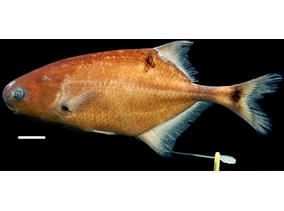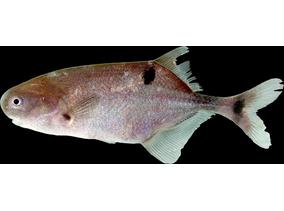Vous êtes ici
Mormyridae
Petrocephalus odzalaensis Lavoué, Sullivan & Arnegard, 2010
Nomenclature
-
Subfamily: PetrocephalinaeGenus: Petrocephalus
SUMMARY
Petrocephalus odzalaensis is a medium sized species within the genus (maximum standard length observed = 99.3 mm; holotype = 92.9 mm). Body ovoid, body 2.6-2.9 longer than high (holotype = 2.6) and laterally compressed. Head length between 3.7 and 4.0 times in standard length (average = 3.9, holotype = 4.0). Snout short and round. Mouth small (4.0 ≤ Head length/mouth width ≤ 4.8, average = 4.3, holotype = 4.3), sub–terminal, opening just under the anterior half of the eye. Teeth small and bicuspid, 8–12 in a single row in the upper jaw (median = 11, holotype = 11), 18–23 in a single row in the lower jaw (median = 20, holotype = 18). Dorsal and anal fins originate in the posterior half of the body (1.5 ≤ standard length/pre–dorsal distance ≤ 1.6 and 1.6 ≤ standard length/pre–anal distance ≤ 1.7, respectively). Pre–dorsal distance slightly greater than the pre–anal distance. Dorsal fin with 20–22 branched rays (median = 21, holotype = 22). Anal fin with 27–29 branched rays (median = 28, holotype = 29). Scales cover the body, except for the head. Lateral line visible and complete with 36–38 (holotype = 38) pored scales along its length. Ten to 14 scales (average = 12, holotype = 11) between the anterior base of the anal fin and the lateral line. Caudal peduncle thin (1.9 ≤ Caudal peduncle length/caudal peduncle distance ≤ 2.3, average = 2.1, holotype = 2.1). Twelve scales around the caudal peduncle. Skin on head thick, turning opaque with formalin fixation. Knollenorgans clustered into the three distinct “rosettes” of Harder (1968).
Body background color pinkish–gray, darker dorsally. Pigmentation pattern consisting of three characteristic black patches: (1) a distinct ovoid black mark below the anterior base of the dorsal fin; (2) a small black mark at the base of the pectoral fin; and (3) an ovoid black mark centered at the base of the caudal fin, which does not extend on the upper and lower lobes. Fins translucent.




